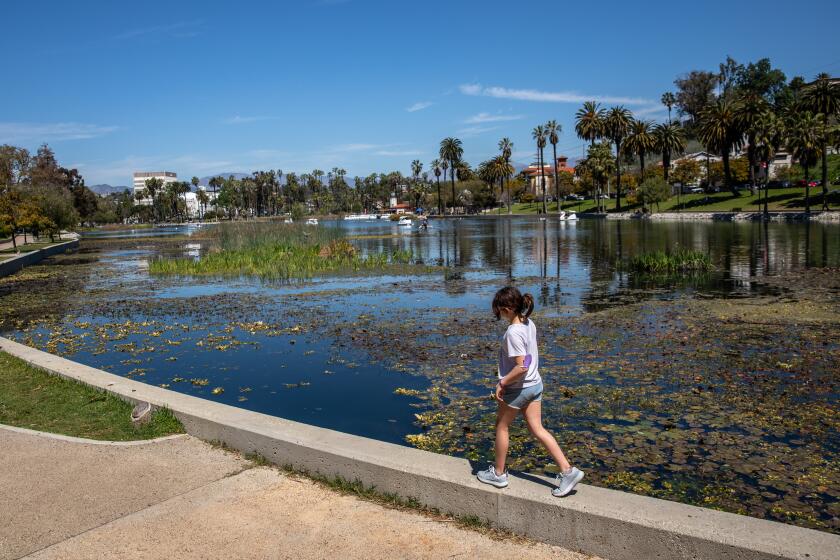Under a threat of mud flows, local mountains drain relatively quickly
Ever since the Station fire swept through the Angeles National Forest last summer, many residents of the foothill communities below the burn area have lived with the fear of destructive mudslides that could come with winter’s heavy storms.
But geologists who have studied this week’s downpours now offer a guardedly optimistic forecast.
Mudslide danger remains, they said Friday, but their observations indicate that the mountains have held up remarkably well despite the naked landscape left by the largest brush fire in Los Angeles County history.
In particular, scientists are downplaying the often-repeated idea that the greatest mudslide danger in the Station fire burn area is likely to be a few days after the rain. Instead, officials from the U.S. Geological Survey found that rainfall drained relatively quickly from the burned mountains, rather than accumulating in a way that would increase the danger over time.
There were some slides this week, but they were all high in the mountains and far from homes.
The potential remains for future landslides, but the imminent danger has been reduced because so much of the rain has already filtered down from the mountains, geologists said.
“For the fire-related runoff, the danger has pretty much passed,” said Kevin Schmidt, a scientist with the USGS, although he emphasized that additional rain could bring new risks.
“Most of the rain that falls is just running off. It’s just not sinking in,” added Sue Cannon, a USGS research geologist.
The San Gabriel Mountains are composed largely of granite and metamorphic, coarse-grained rock that filters water almost like gravel, helping to flush out moisture quickly without producing damaging debris flows, the geologists said.
Though the mountains have generated huge debris flows in the past -- some of them causing major damage and loss of life -- most of those have occurred during intense downpours.
One difference from previous major mudslides is the aggressive efforts by local and county officials to protect foothill neighborhoods. Authorities installed miles of concrete barriers to divert mud flows away from homes, cleared debris basins and deployed an army of tractors to canyons from Acton to La Cañada Flintridge. Tractor operators cleared many minor mud flows and debris basins were largely able to handle the mud and rocks that did tumble down.
Officials also decided to evacuate about 1,200 homes.
Cannon said the mountains ended up getting less rain than forecasters had predicted, and that helped tremendously. The most powerful cells from the storms veered away from the Station fire burn area, she said.
Debris flows have caused dozens of disasters in Southern California over the last century. One of the worst happened early New Year’s Day in 1934, when a 20-foot-high wall of rocks and mud swept over La Crescenta and Montrose, killing 49 people.
That disaster occurred before the creation of L.A.’s modern flood-control system.
On Christmas Day in 2003, a flash flood triggered a debris flow in the wildfire-ravaged San Bernardino Mountains, killing 12 people -- including several children -- at a church retreat in Waterman Canyon.
Some have cited this tragedy in preparing for this week’s storms, but it happened in a remote forest location far from neighborhoods.
Another often-cited comparison is the Ventura County coastal hamlet of La Conchita, which Schmidt described as the “poster child” for large landslides.
But the history of that slide differs considerably from the current situation. In January 2005, during the second-wettest rain year documented in Southern California’s history, heavy rains unleashed 400,000 tons of mud in La Conchita, killing 10 people. A jury later determined that a lack of proper drainage from an avocado ranch at the top of the slope above the community also contributed to the collapse.
La Conchita is also different from the San Gabriel foothills because the town had a well-known history of landslides, with homes that had been built directly in the path of a historically unstable hillside.
Six months after the La Conchita disaster, another landslide hit Bluebird Canyon in Laguna Beach, destroying 17 homes and seriously damaging 11. But Bluebird Canyon has homes built directly atop land with a history of landslides.
Officials prepping the Station fire area said they have learned from past landslides.
“The flood-control system is holding up. It’s working exactly the way it was designed to do,” said Bob Spencer, a spokesman for the Los Angeles County Department of Public Works.
But Spencer and Schmidt cautioned that the preparations won’t be enough if heavier rains soak the mountains.
“We want to prevent a sense of complacency,” Schmidt said Friday. “It’s not like crying wolf. It wasn’t worse, because the rainfall intensity and its duration was not as high as forecasted. If we had gotten what was forecasted, it would have been a lot worse.”
More to Read
Sign up for Essential California
The most important California stories and recommendations in your inbox every morning.
You may occasionally receive promotional content from the Los Angeles Times.












